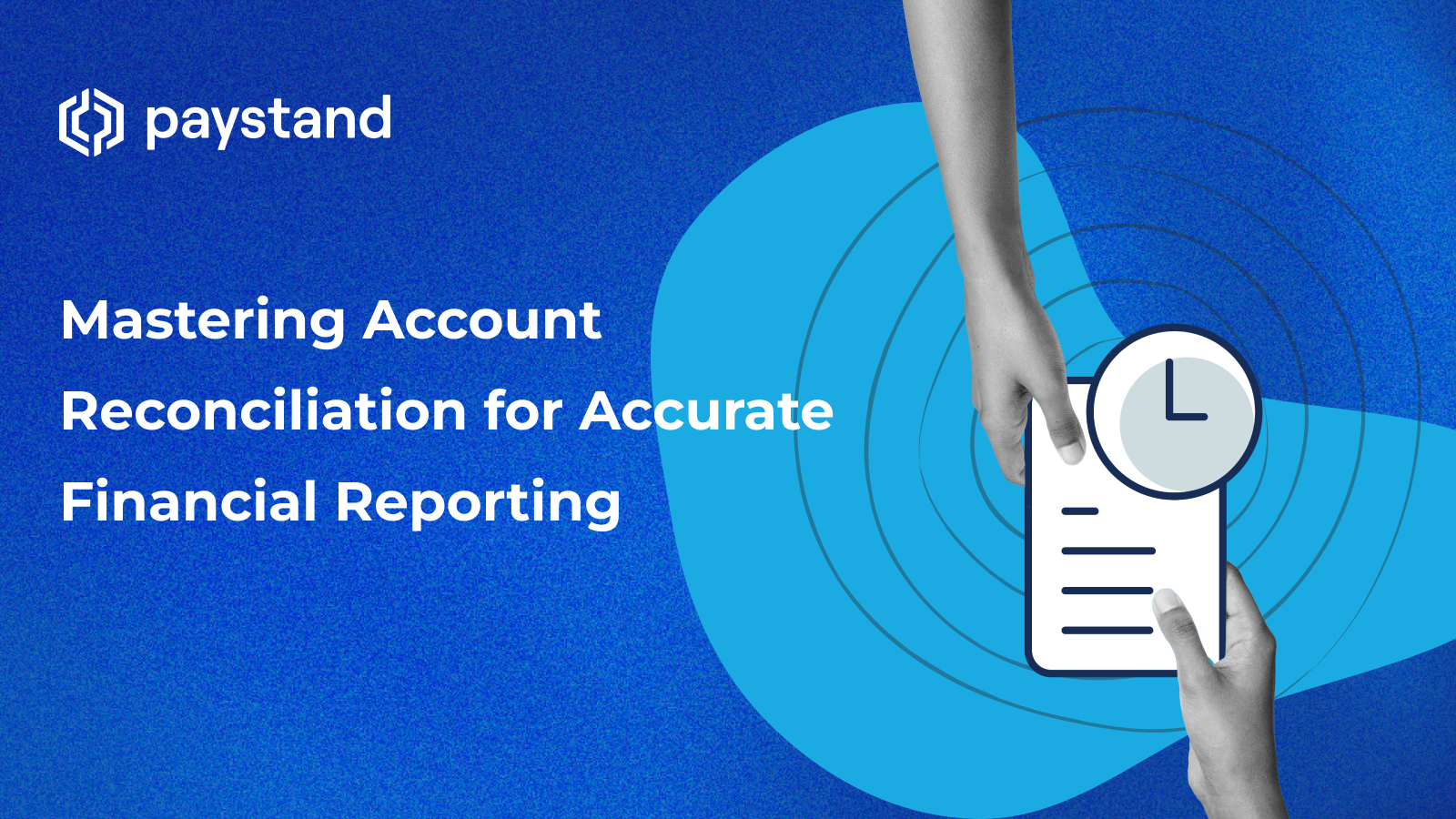Mastering Account Reconciliation for Accurate Financial Reporting

Table of Contents
- What is account reconciliation?
- Why is account reconciliation important?
- How to perform account reconciliation: step-by-step process
- Types of account reconciliation
- Streamline reconciliation with Paystand
Key Takeaways
- Account reconciliation ensures internal financial records align with external statements, supporting accurate financial reporting and identifying discrepancies.
- Reconciliation strengthens regulatory compliance, enhances cash flow management, and helps detect fraud, making it a critical financial control.
- Automating reconciliation with Paystand improves efficiency, accuracy, and real-time cash flow tracking, moving beyond outdated financial systems.
Accurate financial reporting is the foundation of every successful business. Without reliable records, companies can struggle with incorrect cash flow forecasts, poor decision-making, and even compliance issues. One key process that keeps financial reporting in check is account reconciliation. This careful review of financial records helps align internal accounts with external statements, ensuring every transaction is accounted for. It catches errors, reduces fraud risks, and improves cash flow accuracy.
In this guide, we’ll explain what account reconciliation is, why it matters, how to do it, and how automation can simplify the process. Whether you're a seasoned financial controller or just starting your accounting career, mastering reconciliation can boost efficiency and confidence in your financial management.
What Is Account Reconciliation?
Account reconciliation is the process of comparing your company’s financial records to external documents—such as bank statements, customer payments, or vendor invoices—to ensure they match. The goal is to confirm that all recorded transactions are accurate and complete. This helps identify discrepancies, correct errors, and maintain trustworthy financial reporting.
✅ A Simple Example
Imagine your accounting software shows that a customer paid $1,000. However, your bank statement lists only a $950 deposit because of a $50 processing fee. Without reconciliation, that missing amount might not be noticed, leading to incorrect cash flow reports. Regular reconciliation helps uncover these differences and adjust records so everything balances.
💡Pro Tip: Reconciliation isn’t just for bank accounts. It applies to customer balances, vendor payments, and even transactions between different branches or subsidiaries of your business.
What Is a Reconciliation Account?
A reconciliation account acts as a bridge between your subsidiary ledgers and the general ledger. Instead of recording the same transaction in multiple places, reconciliation accounts automatically reflect linked entries. For example, if you have an accounts receivable ledger for customer invoices, the reconciliation account in your general ledger summarizes those balances without duplicating data. This saves time, improves accuracy, and keeps financial records organized.
Why Is Account Reconciliation Important?
Skipping reconciliation can create serious financial risks. Here’s why it’s a critical part of healthy financial management:
- Accuracy in financial reporting: Accurate records are essential for clear financial statements and informed business decisions. Reconciliation ensures that internal ledgers match external records, building a trustworthy foundation for your reports.
- Fraud detection: Discrepancies between accounts can signal fraud. For instance, missing cash deposits or unauthorized transactions may only be noticed when accounts are reconciled regularly.
- Regulatory compliance: Many industries require businesses to follow strict accounting standards. Regular reconciliation helps ensure compliance and keeps you prepared for audits.
- Cash flow management: Reconciling helps businesses understand true cash positions. You’ll know exactly how much money is available once pending deposits, outstanding checks, and fees are factored in.
How to Perform Account Reconciliation: Step-by-Step Process
Step 1: Gather Relevant Documents 📑
Start by collecting all necessary records. This includes internal documents like general ledger entries, and external documents such as bank statements, customer payment receipts, or vendor invoices.
Step 2: Compare Transactions 🔍
Match each transaction from your internal records to the corresponding entry in your external documents. Look closely at amounts, dates, and descriptions to ensure everything lines up correctly.
Step 3: Identify Discrepancies ⁉️
If transactions don’t match, identify what’s causing the difference. Common issues include:
- Bank fees or interest that aren’t recorded in internal accounts
- Duplicate or missing entries
- Delays in processing electronic transfers
Step 4: Investigate and Resolve Issues ✅
Determine the cause of each variance:
- Adjust missing or misposted entries.
- Remove duplicates.
- Record unaccounted-for bank charges.
✅ Example: If a $500 vendor invoice was accidentally paid twice, reconciliation will reveal the error. You would adjust your records to reflect only one payment.
Step 5: Document Adjustments 📝
Once discrepancies are corrected, document the changes with clear notes. Include dates, the reason for adjustments, and who made them. Proper documentation ensures accountability and makes future audits easier.
Types of Account Reconciliation
Different accounts require specific reconciliation methods. Let’s explore the most common types:
- Bank reconciliation: Compares your cash account with bank statements. Differences often come from bank fees, pending deposits, or outstanding checks. Regular bank reconciliation ensures your cash flow statements are correct.
- Vendor reconciliation: It compares accounts payable with vendor statements to confirm invoice accuracy and payments. This ensures businesses aren’t overcharged or missing payment credits.
- Customer reconciliation: For accounts receivable, customer reconciliation verifies that all payments have been received and recorded accurately.
- Intercompany reconciliation: Organizations with multiple legal entities use intercompany reconciliation to ensure transactions between subsidiaries are recorded on both sides.
- General ledger reconciliation: This involves comparing individual general ledger accounts, such as fixed assets or inventory, to detailed supporting records.
Benefits of Automating Account Reconciliation
Traditional reconciliation can be time-consuming and prone to errors when done manually. Automation offers several advantages:
- Speed and efficiency: Automation tools streamline repetitive tasks, reducing the time it takes to reconcile accounts.
- Improved accuracy: Automated systems flag discrepancies faster and minimize human error, leading to more reliable records.
- Real-time cash flow insights: Automated solutions provide up-to-date visibility into cash positions, helping businesses make informed financial decisions.
Streamline Reconciliation with Paystand
Account reconciliation is more than a routine task—it’s a vital process that safeguards financial accuracy, prevents fraud, and supports strategic decision-making. With tools like Paystand, you can revolutionize your accounts receivable management by automating manual processes and eliminating inefficiencies. Our cutting-edge solutions help businesses move beyond outdated financial systems, empowering you with real-time visibility and unmatched precision in cash flow tracking.
Ready to elevate your financial operations? Discover how Paystand can simplify account reconciliation and enhance your organization's efficiency. Book a demo today to see how we can help transform your financial processes.







